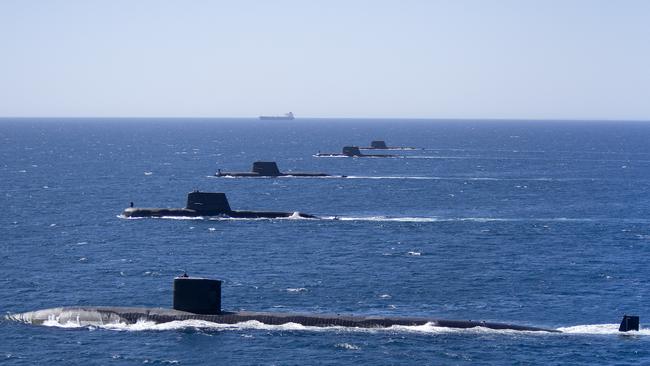US congress asked to consider alternative AUKUS plan
A leading US naval analyst has proposed to the US congress an AUKUS ‘alternative’ whereby the Americans would operate eight nuclear subs from Australia, but retain full control over them.

The US congress has been handed an alternative AUKUS plan whereby it would not sell nuclear-powered submarines to Canberra and instead build up to eight new Virginia-class boats that could be retained in US Navy service and operated out of Australia.
The eight extra Virginia-class submarines could be used for both US and Australian missions while freeing up funds for Canberra to invest in other capabilities such as long-range anti-ship missiles, drones, loitering munitions, B-21 long-range bombers, or other strike aircraft.
The idea is canvassed by Ronald O’Rourke, a highly regarded specialist who has worked as a naval analyst for the Congressional Research Service of the Library of Congress since 1984, who labels the alternative model a US/Australian “military division of labour”.
It has won the backing of one of Australia’s leading strategic experts, Michael Shoebridge, who said Mr O’Rourke sought to present a “better plan that achieves the deterrence outcomes of AUKUS but does so in a faster and more cost-effective way”.

Mr Shoebridge, the founder and director of Strategic Analysis Australia, said “AUKUS is not actually about submarines – AUKUS is about deterring war with China by having increased military power that keeps making Xi Jinping think today is not the right day”.
“The alternative force Ronald O’Rourke sketches out with the B-21 bombers and new generation weapons and autonomous systems would be a more sovereign force than the current plan.”
By contrast, former home affairs secretary and leading strategic thinker Mike Pezzullo rejected Mr O’Rourke’s “model of keeping all of the SSNs for the US navy” and proposed a major lift in defence spending to boost submarine production rates.
The alternative AUKUS proposal from Mr O’Rourke, contained in an updated October 10 paper for members and committees of congress, would appear to clash with longstanding assurances from successive Australian governments that submarines provided by the US would remain under the sovereign control of the government of Australia.
Under the alternative model, Mr O’Rourke says that “up to eight additional Virginia-class SSNs would be built, and instead of three to five of them being sold to Australia, these additional boats would instead be retained in US Navy service and operated out of Australia along with the five US and UK SSNs that are already planned to be operated out of Australia under Pillar 1 as SRF-West (Submarine Rotational Force-West)”.
Mr O’Rourke links the case for the alternative model to concerns over whether the US industrial base can meet the target of producing 2.33 Virginia-class submarines per year – the rate needed to replace the boats sold to Australia.
The US Navy’s goal, set out in June 2023, called for maintaining a fleet of 66 SSNs (nuclear-powered attack submarines), but Mr O’Rourke notes there were only 48 in service in 2023.
He says the number of SSNs is projected to experience a “valley or trough from the mid-2020s through the early 2030s”.
Under the US Navy’s 30-year shipbuilding plan, the SSN force is forecast to decline to 47 boats in 2030, marking the bottom of the “valley”. It would then increase to 50 boats by 2032 and up to 66 boats by 2054.
Mr O’Rourke says these projected force levels do not account for the impact of selling three to five Virginia-class boats to Australia under AUKUS.

Mr Pezzullo said selling SSNs to Canberra was a “significant strategic risk for the US, and would only continue to be supported by a president who was confident Australia would support the US in any war in the Western Pacific and Indian Ocean.”
“That is why AUKUS Pillar 1 could be suspended or terminated at any time if military necessity required it,” he said. “We will then be left without Virginia SSNs.”
Mr Pezzullo said the “only solution to the problem is to dramatically lift production capacity and production to a rate of effort that would typically only be seen as an urgent wartime measure – perhaps lifting production to three to four submarines a year to meet US Navy and Royal Australian Navy requirements – this would require US and Australian defence/GDP spending to lift into the 4-5 per cent range”.
In his paper, Mr O’Rourke lists arguments both in favour of the existing AUKUS arrangements as well as his alternative plan. But he says the lack of assurance from Australia that any nuclear submarines sold to it would “be available for use in a US-China crisis or conflict” was important. This was cited as a key reason not to sell Australia the submarines in the first place.
“This could weaken rather than strengthen deterrence and warfighting capability in connection with a US/China crisis or conflict,” Mr O’Rourke says. “Selling Virginia-class boats to Australia could also weaken deterrence … if China were to find reason to believe, correctly or not, that Australia might use its Virginia-class boats less effectively than the US Navy.”
He notes that Defence Minister Richard Marles in March 2023 “reportedly confirmed that in exchange for the Virginia-class boats, Australia’s government made no promises to the US that Australia would support the US in a future conflict over Taiwan”.
Mr Shoebridge said that, under the existing AUKUS plan, Australia would not achieve have eight nuclear submarines until 2054.
“When Australia has eight, that is the time we can reliably deploy two at any one time,” he said.
“I do (prefer O’Rourke’s plan). The complexity and time and expense of the AUKUS submarine plan and the fact that it takes more than 30 years to allow us to have two reliably deployed submarines means it’s not solving the problem that AUKUS sets out to solve.”







To join the conversation, please log in. Don't have an account? Register
Join the conversation, you are commenting as Logout